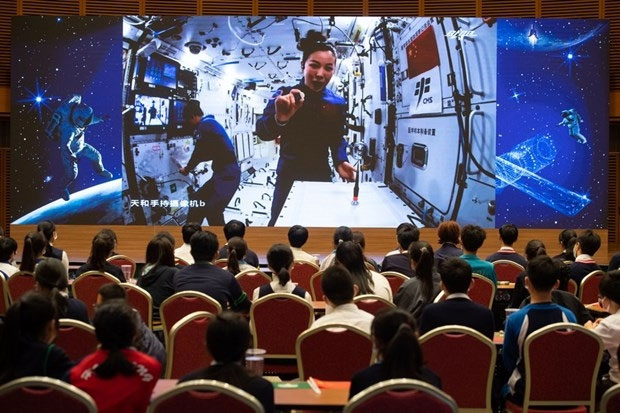During a live online class from space, Chinese astronauts guided students on Earth through the living and working areas of the space station.
The first online class from China’s space station for students on Earth took place on December 9, conducted by the crew of the Shenzhou-13 spacecraft.

A photo taken in Macao, Southern China on December 9, 2021, showing Shenzhou 13 crew member Wang Yaping teaching from China’s space station via video call. (Photo: chinadaily.com.cn)
The class began at 3:40 PM (Beijing time) with a total of 1,420 students attending from five classrooms set up across China. The main classroom was located at the China Science and Technology Museum.
Other classrooms were set up in Nanning in Guangxi Province, Wenchuan County in Sichuan Province, and in the two special administrative regions of Hong Kong and Macao.
During the session, with the help of two colleagues, astronaut Wang Yaping showed students around the living and working areas of the space station.
Students could see the microwave, water purifier, and refrigerator in the kitchen.
In response to a question from a student in Hong Kong about drinking water, astronaut Wang Yaping explained that the water they drink has been recycled and that there is no difference in taste between regular water and recycled water. She noted that with the water recycling system, every drop of water in the space station is fully utilized.
According to Wang Yaping, astronauts may appear slightly plump due to the microgravity environment in space, which can affect blood circulation. They use a treadmill, exercise bike, and resistance bands to maintain their health.
Meanwhile, astronaut Zhai Zhigang introduced the suit that astronaut Ye Guangfu was wearing during the class. According to Zhai Zhigang, this jumpsuit has several elastic bands inside to help astronauts maintain their muscle strength.
Subsequently, astronaut Ye Guangfu presented experiments related to cell development in a weightless environment in space.
They compared the growth and shape of cells in artificial gravity and microgravity to study their changing rules and mechanisms.
In October, the Shenzhou 13 spacecraft carried three astronauts, including Zhai Zhigang, Wang Yaping, and Ye Guangfu, into space with the mission of constructing China’s space station.
Astronaut Zhai Zhigang was the first Chinese person to leave footprints in space during the Shenzhou 7 mission in 2008; astronaut Ye Guangfu is making his first flight into space, and astronaut Wang Yaping is the first female astronaut to be present at the space station and step outside into space from China.


















































